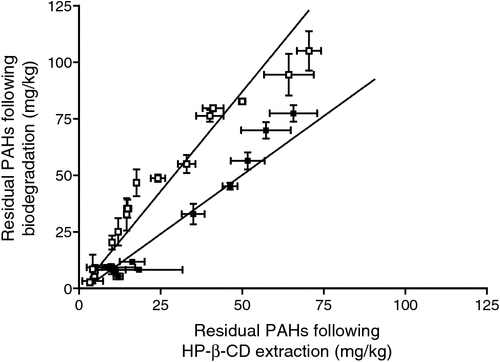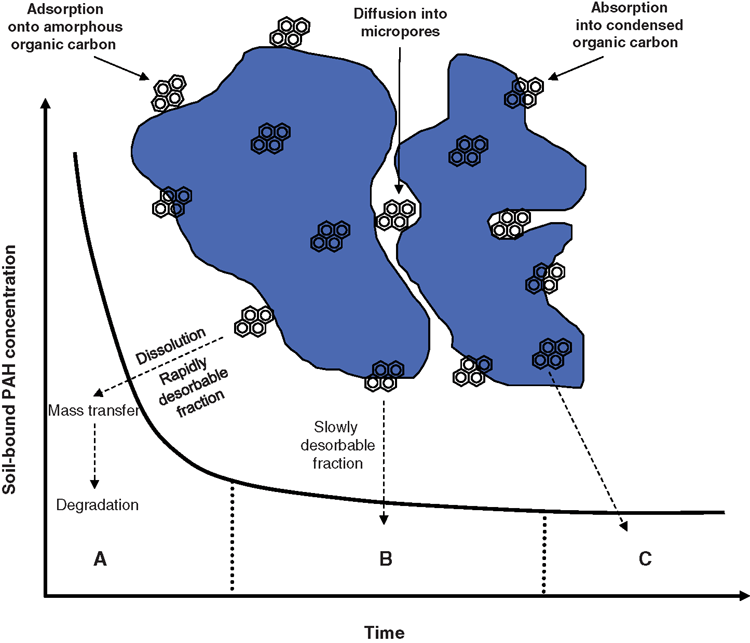Bioavailability and biodegradation of polycyclic aromatic hydrocarbons
Albert L JuhaszCentre for Environmental Risk Assessment and Remediation (CERAR)
University of South Australia and Cooperative Research Centre for Contamination Assessment and Remediation of the Environment (CRC CARE)
Mawson Lakes, Adelaide
SA 5095, Australia
Tel: +61 8 8302 5045
Fax: +61 8 8302 3057
Email: Albert.Juhasz@unisa.edu.au
Microbiology Australia 35(4) 199-200 https://doi.org/10.1071/MA14064
Published: 30 October 2014
Contaminant bioavailability plays an influential role in the efficacy of polycyclic aromatic hydrocarbon biodegradation.
Polycyclic aromatic hydrocarbons (PAHs) are ubiquitous environmental pollutants arising from the incomplete combustion of organic material. Both anthropogenic (e.g. processing and combustion of fossil fuels, waste incineration) and geogenic processes (e.g. fires, volcanoes) contribute to the burden of PAHs in environmental matrices1. The concern regarding the presence of PAHs in the environment and their potential to exert toxic, mutagenic and carcinogenic effects2 has led to the development of a number of physical, chemical and biological techniques for the remediation of PAH-contaminated soil. Bioremediation is considered a ‘green’ technology for the remediation of PAH-contaminated soil; however, its efficacy is dependent on a number of variables including the presence and activity of PAH degrading microorganisms (e.g. genera of Burkholderia, Mycobacterium, Pseudomonas, Sphingomonas, Stenotrophomonas), physico-chemical properties of the PAHs (which will influence their biodegradability) and environmental parameters including the availability of essential nutrients and oxygen, soil pH, moisture and temperature3. Another parameter that is influential for bioremediation success is PAH bioavailability. In the context of PAH biodegradation, bioavailability refers to the fraction of the total soil-bound PAH concentration that is desorbable from the soil matrix and is therefore potentially available for biodegradation4.
Following their entry into the soil environment, PAHs may diffuse and be occluded in soil micropores4, which limits their propensity for desorption and therefore their bioavailability for biodegradation. However, the predominant mechanism for PAH retention within the soil matrix, and the reduction in PAH bioavailability, is via sorption to organic carbon (OC)5. PAH retention is influenced by the nature of the OC (i.e. amorphous or rubbery versus condensed or glassy) in addition to the octanol-water partitioning co-efficient (Kow) of the PAH. The interaction between PAHs and amorphous domains constitutes a rapid sorption phase but is susceptible to rapid desorption while association with condensed OC results in slow sorption-desorption behaviour5. As suggested by Semple et al.4, PAH bioavailability may be estimated using methodologies that quantify the rapidly and slowly desorbable domains (e.g. non-exhaustive extraction methods) as these fractions represent PAHs that have the potential to partition into soil solution and be available for biodegradation (Figure 1).
A non-exhaustive extraction method, utilising hydroxypropyl-β-cyclodextrin (HP-β-CD), has been shown to provide an estimate of the desorbable PAH fraction from contaminated soil that may therefore be available for biodegradation6–9. The methodology, albeit simplistic, involves extraction of PAH-contaminated soil with HP-β-CD (40 mM) at a soil:solution ratio of 1:20 for 20 h. Following extraction, soils are retrieved via centrifugation, dried and the residual PAH concentration determined following ‘exhaustive’ extraction and GC / HPLC analysis. The desorbable fraction is calculated by the difference between the initial PAH concentration and the residual PAH concentration following HP-β-CD extraction. A number of studies have shown the correlation between PAH bioavailability estimates, utilising HP-β-CD extraction, and PAH biodegradation/mineralisation, utilising soil microcosms6–9. This suggests that non-exhaustive extraction methods, such as HP-β-CD, may be utilised to predict the endpoints of PAH biodegradation based on bioavailability.
The slope of the bioavailability-biodegradability relationship may, however, vary for individual PAHs due to differences in their physico-chemical properties which will influence desorption and biodegradability (Figure 2). For example, a number of researchers have determined that the slope of the bioavailability-biodegradability relationship for three-ring PAHs is close to 1 (0.85–1.01), indicating the similarity of HP-β-CD extraction to remove low molecular weight PAHs to the same extent as biodegradation. However, for five-ring compounds, the slope of the bioavailability-biodegradability relationship may range up to 1.60 indicating that larger residual PAH fractions remain in the soil following biodegradation compared with HP-β-CD extraction. Although a disparity exists between PAH bioavailability and biodegradability, as a consequence high molecular weight (HMW) PAH biodegradation limitations (i.e. high activation energy, unfavourable Gibbs free energy and slow transport across cell membranes), the linearity of the bioavailability-biodegradability relationship suggests that it may be utilised for predicting the extent of HMW PAH biodegradation. As a consequence, the assessment of PAH bioavailability (using HP-β-CD extraction) and the prediction of PAH bioremediation efficacy, has the potential to be used to screen the appropriateness of bioremediation strategies prior to on-site implementation. This would benefit industry by providing a simple, rapid and inexpensive assay for determining the endpoints of PAH bioremediation.

|
Acknowledgements
The author acknowledges the support of the Centre for Environmental Risk Assessment and Remediation, University of South Australia and the Cooperative Research Centre for Contamination Assessment and Remediation of the Environment.
References
[1] Juhasz, A.L. and Naidu, R. (2000) Bioremediation of high molecular weight polycyclic aromatic hydrocarbons: a review of the microbial degradation of benzo[a]pyrene. Internat. Biodeterior. Biodeg. 45, 57–88.| Bioremediation of high molecular weight polycyclic aromatic hydrocarbons: a review of the microbial degradation of benzo[a]pyrene.Crossref | GoogleScholarGoogle Scholar | 1:CAS:528:DC%2BD3cXmsFaksbk%3D&md5=51d5ae677fa983c165330e18237da254CAS |
[2] ATSDR (1995) Agency for Toxic Substances and Disease Registry, Toxicological profile for polycyclic aromatic hydrocarbons. Atlanta, GA, US Department of Health and Human Services.
[3] Johnsen, A.R. et al. (2005) Principles of microbial PAH-degradation in soil. Environ. Pollut. 133, 71–84.
| Principles of microbial PAH-degradation in soil.Crossref | GoogleScholarGoogle Scholar | 1:CAS:528:DC%2BD2cXmvFylurc%3D&md5=73000b39ea15d41253852f8b0ead6cfdCAS | 15327858PubMed |
[4] Semple, K.T. et al. (2003) Bioavailability of hydrophobic organic contaminants in soils: fundamental concepts and techniques for analysis. Eur. J. Soil Sci. 54, 809–818.
| Bioavailability of hydrophobic organic contaminants in soils: fundamental concepts and techniques for analysis.Crossref | GoogleScholarGoogle Scholar | 1:CAS:528:DC%2BD2cXitlOn&md5=5a5532409f0aabb816e30461d15c16d2CAS |
[5] Pignatello, J.J. and Xing, B. (1996) Mechanisms of slow sorption of organic chemicals to natural particles. Environ. Sci. Technol. 30, 1–11.
| Mechanisms of slow sorption of organic chemicals to natural particles.Crossref | GoogleScholarGoogle Scholar | 1:CAS:528:DyaK2MXpsFyrsr0%3D&md5=30eb9803fc3bac6f7336c516e1a22103CAS |
[6] Reid, B.J. et al. (2000) Bioavailability of persistent organic pollutants in soils and sediments – a perspective on mechanisms, consequences and assessment. Environ. Pollut. 108, 103–112.
| Bioavailability of persistent organic pollutants in soils and sediments – a perspective on mechanisms, consequences and assessment.Crossref | GoogleScholarGoogle Scholar | 1:CAS:528:DC%2BD3cXhs1ahs7s%3D&md5=d814594e68672819de18b801e4a78b89CAS | 15092971PubMed |
[7] Juhasz, A.L. et al. (2005) Predicting the efficacy of polycyclic aromatic hydrocarbon bioremediation in creosote-contaminated soil using bioavailability assays. Bioremediat. J. 9, 99–114.
| Predicting the efficacy of polycyclic aromatic hydrocarbon bioremediation in creosote-contaminated soil using bioavailability assays.Crossref | GoogleScholarGoogle Scholar | 1:CAS:528:DC%2BD2MXhtFaks7%2FL&md5=d37516c7a0ccdc99fde65417651d2d69CAS |
[8] Mahmoudi, N. et al. (2013) Assessing limitations for PAH biodegradation in long-term contaminated soils using bioaccessibility assays. Water Air Soil Pollut. 224, 1411.
| Assessing limitations for PAH biodegradation in long-term contaminated soils using bioaccessibility assays.Crossref | GoogleScholarGoogle Scholar |
[9] Rostami, I. and Juhasz, A.L. (2013) Bioaccessibility-based predictions for estimating PAH biodegradation efficacy – comparison of model predictions and measured endpoints. Internat. Biodeterior. Biodeg. 85, 323–330.
| Bioaccessibility-based predictions for estimating PAH biodegradation efficacy – comparison of model predictions and measured endpoints.Crossref | GoogleScholarGoogle Scholar | 1:CAS:528:DC%2BC3sXhs1Oru7jO&md5=b22da043f9905408ffc235aa06a44b29CAS |
Biography
Albert Juhasz is an Associate Professor at the Centre for Environmental Risk Assessment and Remediation, University of South Australia. His research interests include the development of remediation strategies for contaminated soils and the assessment of contaminant bioavailability and bioaccessibility for refining human health exposure assessment.



